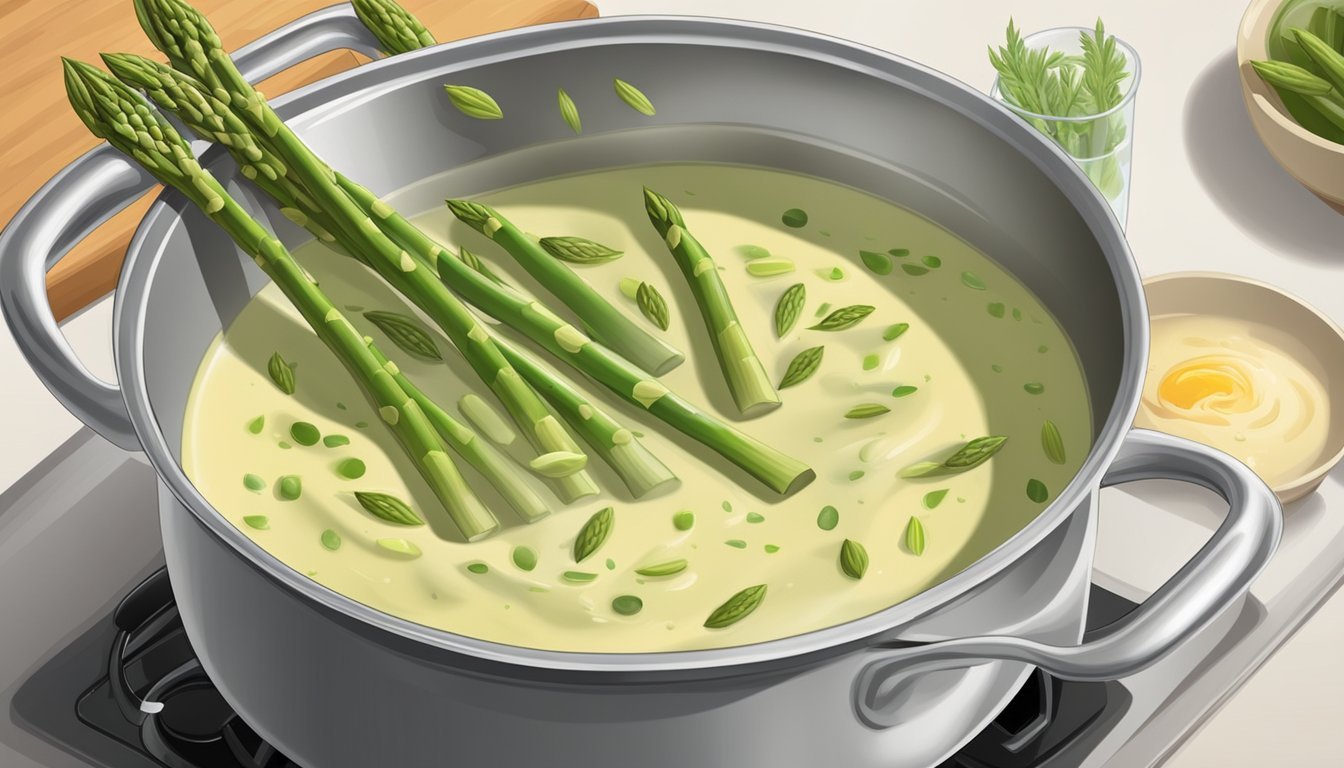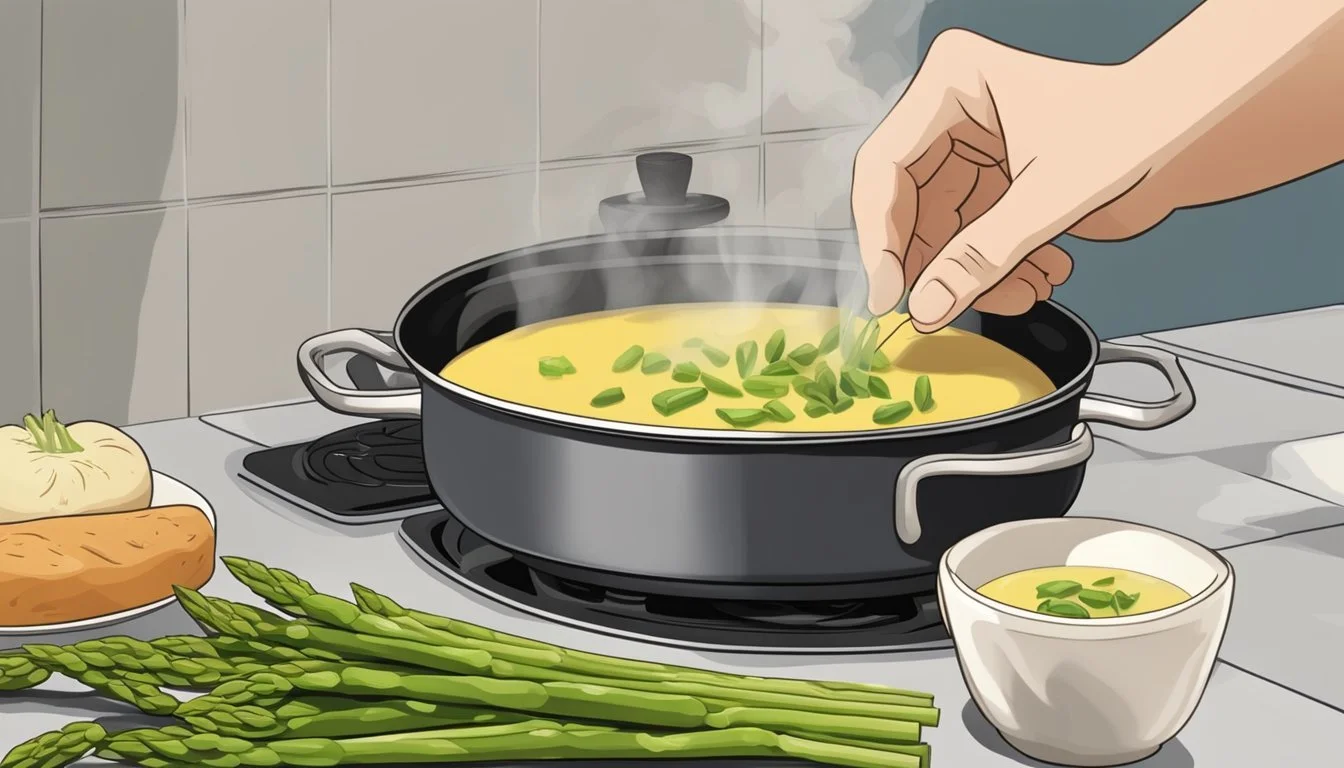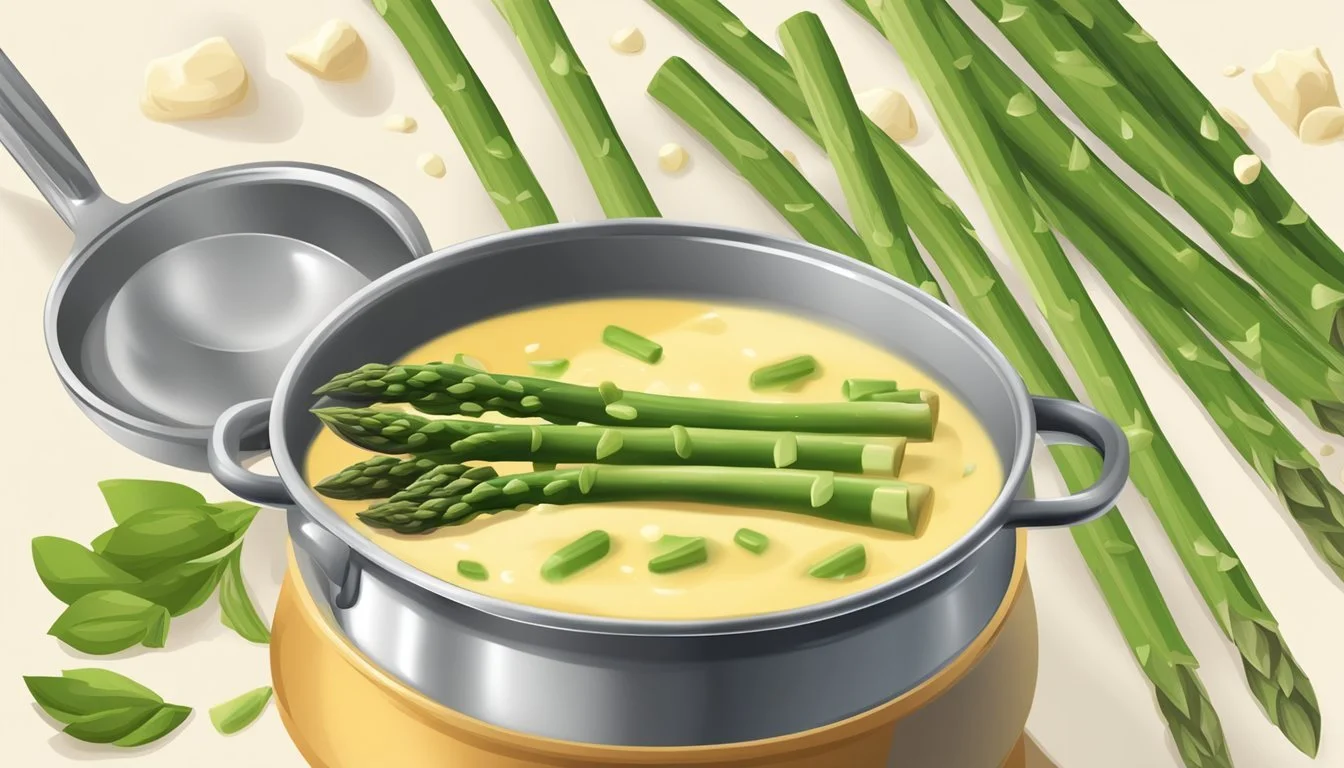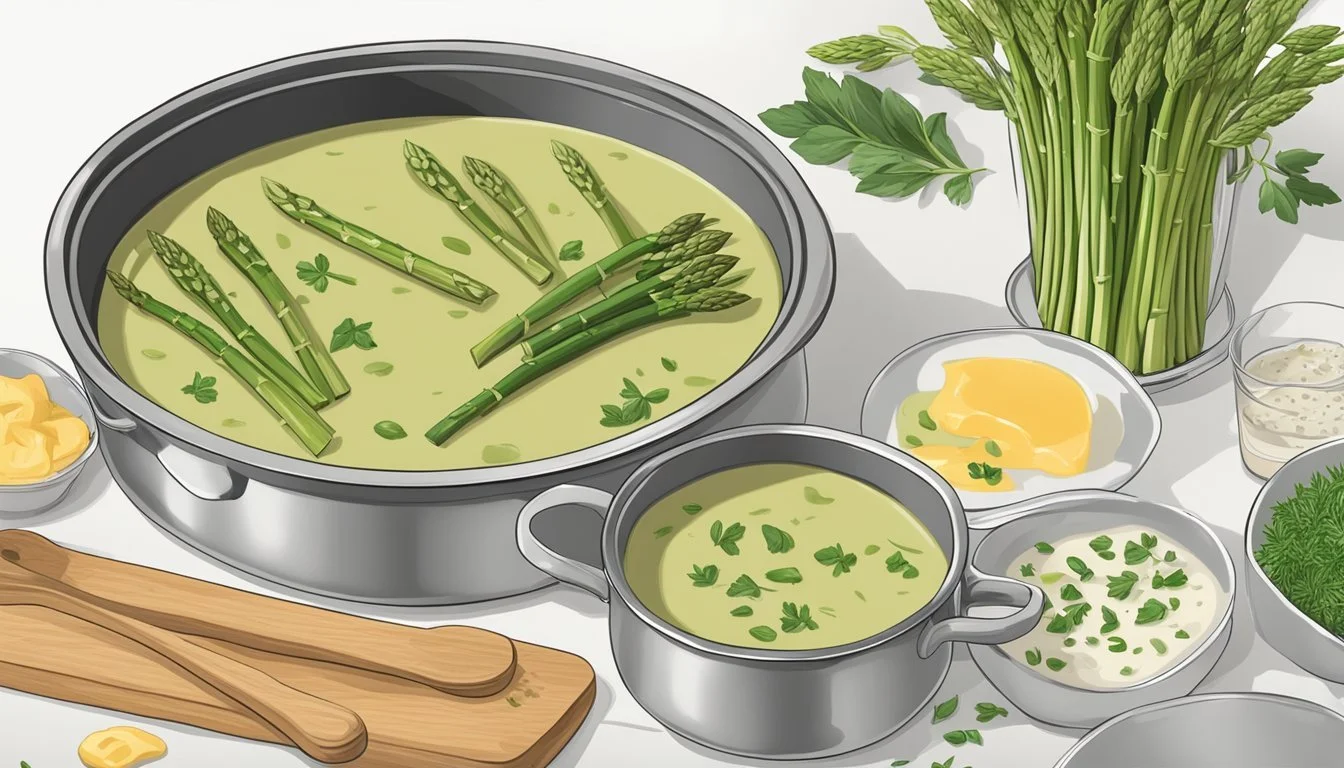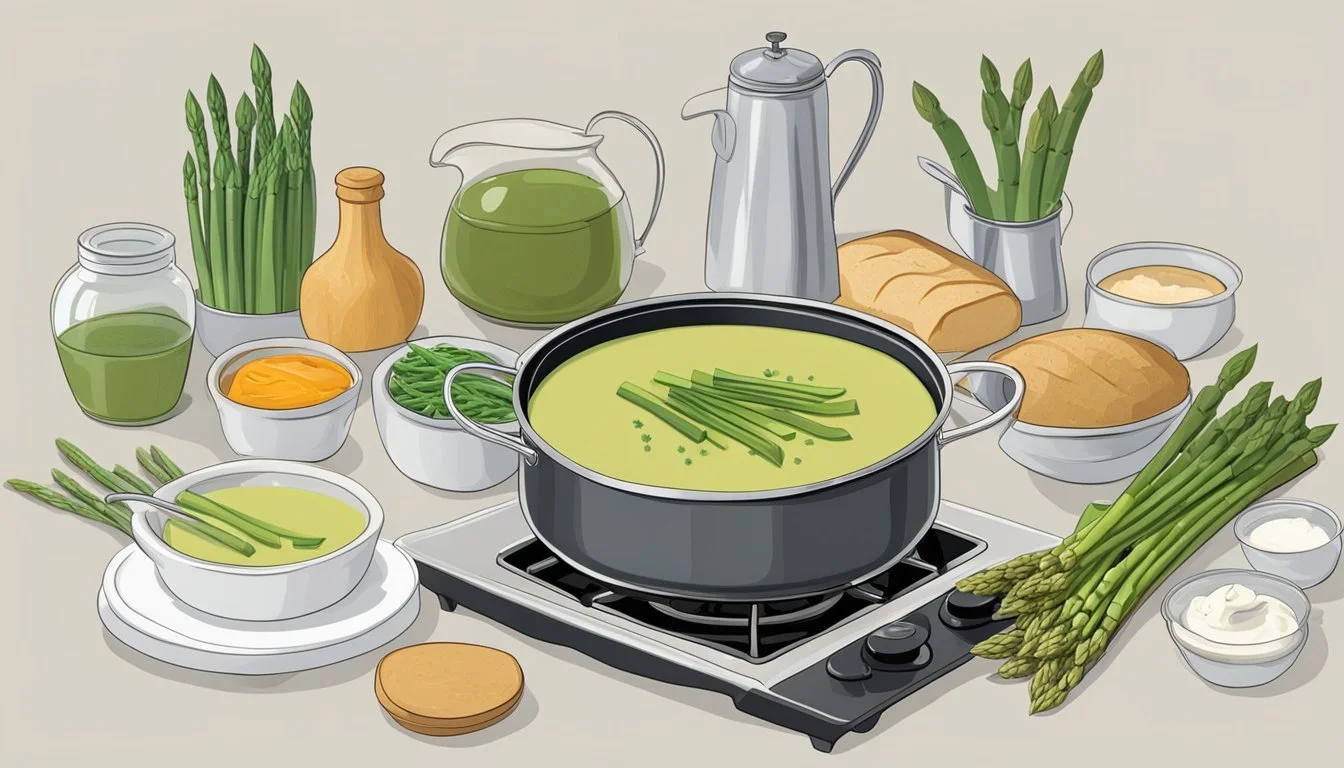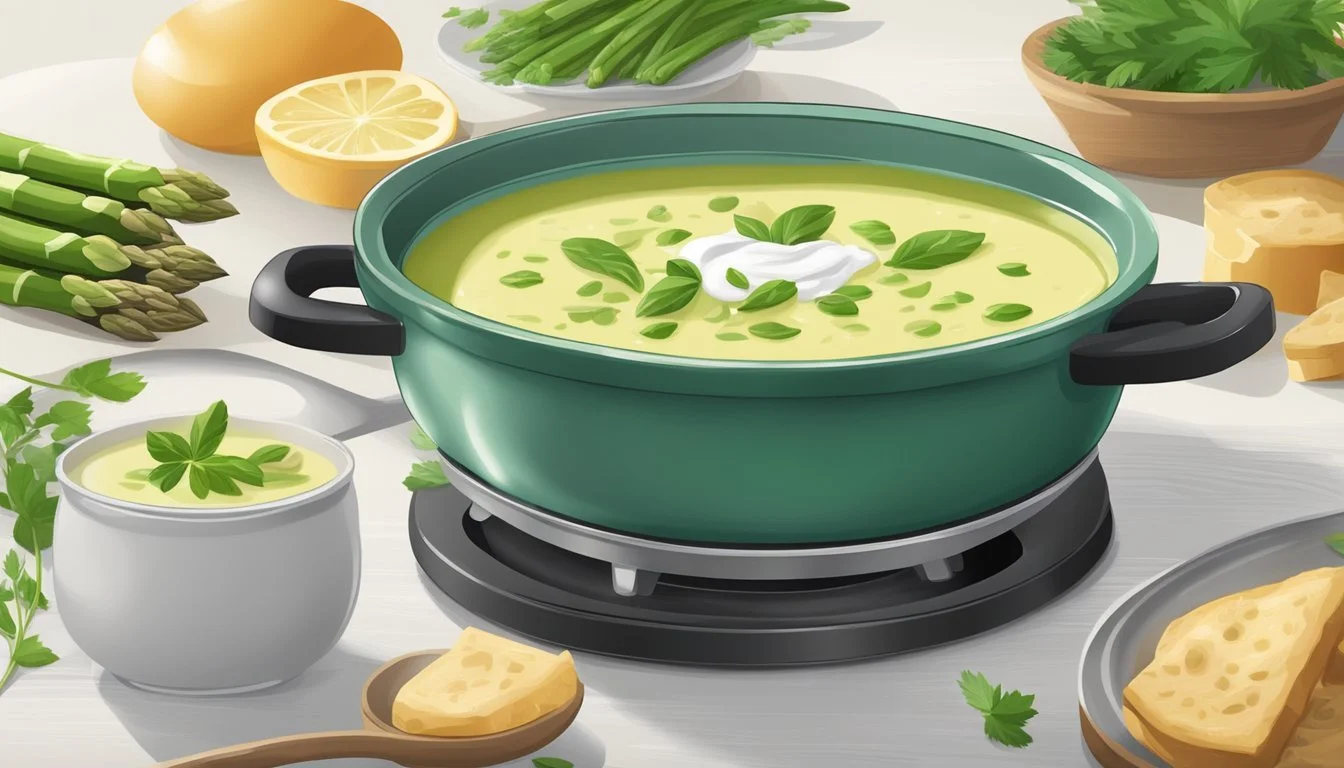Asparagus End Soup
A Creamy, Seasonal Starter Perfect for Spring Dinners
Asparagus (What wine goes well with asparagus?) End Soup is a creamy, seasonal starter known for its velvety texture and rich flavors. A resourceful way to use the entire asparagus spear, this soup transforms the often-discarded ends into a dish that epitomizes spring. The process begins with cooking the tougher ends until they are tender enough to blend into a smooth puree, which forms the soup's base. The creaminess of the soup is typically enhanced not only by the pureed asparagus ends but also by the addition of dairy, such as cream or half-and-half, creating a luxurious mouthfeel that is both satisfying and light.
Simplicity is key in seasoning this refined appetizer; just a sprinkle of salt and pepper can elevate the natural, earthy taste of the asparagus. The inclusion of onions, sautéed until sweet and translucent, contributes a subtle depth without overpowering the star ingredient. As a starter, Asparagus End Soup sets the tone for the meal with its comforting warmth and understated elegance, offering a taste of spring's bounty in every spoonful. It reminds diners that even the most humble parts of vegetables can be transformed into a dish with remarkable flavor and sophistication.
Selecting Your Ingredients
Crafting a superior Asparagus End Soup hinges on the quality of ingredients used. This section outlines the best choices to ensure a creamy and flavorful starter.
Choosing Fresh Asparagus
When selecting fresh asparagus, look for bright green stalks with firm, tightly closed tips. Size is a matter of preference, but medium spears often provide the ideal balance of tenderness and flavor.
Onions and Garlic: Flavor Foundations
Onions and garlic are essential for a flavorful base. Choose yellow onions for their ideal balance of sweetness and astringency, and use fresh garlic cloves for the most robust flavor.
Cream Options for Richness
For richness, heavy cream or full-fat milk are the go-tos. If a lighter soup is desired, half-and-half can be a suitable alternative without compromising the creamy texture too much.
Broth Selection: Chicken or Vegetable?
The choice between chicken broth and vegetable broth depends on your preference for a meatier or more vegetal flavor profile. Use unsalted butter and unsalted broth for better control over the soup's seasoning.
Additional Essential Ingredients
Butter: Preferably unsalted, for sautéing without adding extra salt.
Potatoes: A starchy variety to add body and creaminess without cream.
Lemon juice: Freshly squeezed for a bright finishing note.
Garnish: Chopped herbs or a swirl of cream for presentation.
This assemblage of handpicked ingredients will yield a soup that excels in taste and texture.
Preparing the Asparagus
Preparing the asparagus correctly is essential for a smooth, creamy soup. The process involves trimming the woody ends, deciding between roasting and boiling, and choosing the right blending equipment.
Trimming Asparagus Ends
To begin, one should wash the asparagus and lay them out on a cutting board. Using a sharp knife, they must trim the woody asparagus ends, which are typically tough and fibrous. An easy method is to bend each stalk until it snaps naturally; the asparagus breaks where the tender part ends and the woody texture begins.
Roasting or Boiling?
The asparagus tips and stalks can be cooked in two primary ways: roasting or boiling. Roasting at a high temperature enhances flavor but can take longer and requires occasional stirring. Boiling is quicker and often preferred if time is limited.
Roasted Asparagus: Preheat the oven to 425°F (220°C), drizzle the asparagus with olive oil, season with salt and pepper, and roast for 12-15 minutes.
Boiled Asparagus: Submerge the asparagus in boiling water for 3-5 minutes or until they are tender.
Blender Versus Immersion Blender
After cooking, transfer the asparagus to either a blender or use an immersion blender for puréeing. A blender often produces a smoother texture, but one should be cautious of hot liquids which can create pressure when covered tightly.
Blender: Use in batches for a consistent blend.
Immersion Blender: Blend directly in the pot for convenience and less cleanup.
For either method, retain some of the cooking liquid to adjust the soup's consistency. The remaining prep work is minimal, ensuring a creamy and flavorful asparagus end soup.
The Cooking Process
The preparation of Cream of Asparagus Soup hinges on a few critical steps in the cooking process to ensure robust flavor and a silken texture. Paying attention to the sauté, simmer, and texture is key.
Mastering the Sauté
To begin, one must sauté the aromatic base. The chef should use olive oil to gently cook the yellow onion until it's translucent, typically taking about 5 minutes. This foundational step releases the savory flavors essential to the soup's complexity.
Heat olive oil in a pot over medium heat.
Add finely chopped yellow onion; sauté until soft.
Simmering the Soup
Subsequent to the sauté, asparagus ends are added to the pot. The soup should simmer until the asparagus is tender, which usually takes 30-45 minutes. A generous seasoning of salt and black pepper during the simmering phase amalgamates the flavors.
Cover asparagus with water, an inch above the vegetable.
Simmering time: approximately 30-45 minutes.
Season with salt and black pepper.
Achieving the Perfect Texture
After the asparagus is tender, achieving the perfect creamy texture is attained through puréeing and the addition of cream. Adding a roux or cream enhances the soup's silkiness. The chef needs to ensure to blend until smooth, and if using cream, to warm it gently to avoid curdling.
Purée the soup until smooth using a blender or immersion blender.
Stir in cream or a roux to add richness and texture.
Warm the soup, avoiding boiling post cream addition.
Enhancing the Flavor
To elevate the taste of Asparagus End Soup, one must consider not only the core ingredients but also the strategic use of garnishes and pairings. These elements work in harmony to enhance the soup's flavor profile, turning a simple dish into a memorable starter.
The Role of Garnishes
Garnishes do more than add visual appeal; they contribute layers of flavor and texture to Asparagus End Soup. A sprinkle of freshly grated Parmesan adds a salty, umami note, while chopped chives or parsley introduce a fresh, herbaceous element. For a touch of brightness, a squeeze of lemon juice can work wonders. Consider this selection of garnishes to accentuate the soup's taste:
Fresh herbs: Thyme, dill, parsley
Cheese: Freshly grated Parmesan
Acidity: Lemon juice
Crunch: Homemade croutons
Accompaniments and Pairings
Asparagus End Soup pairs beautifully with various accompaniments that complement its creamy texture and rich flavor. A side of crusty bread or a lightly toasted slice of baguette makes for a delightful textural contrast, while small salad with a vinaigrette dressing can balance the soup's creaminess. When seasoning, a pinch of salt and pepper is essential to bring out the natural flavors of the asparagus. Pair the soup with a crisp white wine for an elegant dining experience. Here are some effective pairings:
Breads: Baguette, sourdough, ciabatta
Salads: Green salad with a simple vinaigrette
Seasonings: Salt, black pepper
Wine Pairing: Sauvignon Blanc or Pinot Grigio
Nutritional Information
This section explores the health implications of consuming Asparagus End Soup, focusing on the nutrients it provides and alternatives for dietary preferences.
Benefits of Asparagus
Asparagus is a nutrient-packed vegetable high in fiber, which aids in digestion and promotes heart health. It is also a good source of protein, essential for muscle repair and building. They contain a variety of essential vitamins and minerals, such as vitamin K, vitamin A, and folate, making them a beneficial ingredient in soups (What wine goes well with soups?).
Considering Dairy Alternatives
Dairy products, such as sour cream or heavy cream, often enrich creamy soups, contributing to a higher calorie and fat content. However, for those considering their waistline or opting for plant-based options, Greek yogurt can be a healthful substitute, offering a creamy texture with more protein and less fat. Moreover, for a vegan option, coconut milk or cashew cream provides a similar richness without animal derivatives.
Soup as a Healthy Choice
When considered as part of a balanced diet, Asparagus End Soup can be a healthy choice. By being mindful of the ingredients used, one can enjoy a comforting bowl of soup that supports their nutritional goals. Here are key considerations for making this soup a healthy addition to any meal:
Fiber: Asparagus is a high-fiber ingredient, which contributes to satiety and digestive health.
Protein: Adding ingredients like lentils or chickpeas can increase the protein content for a more filling dish.
Healthy Fats: Opting for dairy alternatives can reduce saturated fat intake, while adding healthy fats like olive oil can provide essential fatty acids.
Calories: Being conscious of portion size and ingredient choices can help manage overall calorie intake.
Recipe Variations
Variations of Asparagus End Soup allow for dietary accommodations and the addition of proteins. By tweaking a few ingredients, one can transform the classic cream of asparagus soup into a dish that satisfies particular dietary needs or cravings for a more protein-rich meal.
Dietary Tweaks
Vegetarian and Vegan Alternatives: Traditional cream of asparagus soup often includes chicken broth and heavy cream, but these can be easily substituted to cater to vegetarian and vegan diets. For a vegetarian version, simply replace the chicken broth with vegetable broth. Vegans can go further by using plant-based creams or thickening agents. Here’s a quick guide:
Broth Substitute: Use vegetable broth instead of chicken broth.
Cream Substitute: Opt for coconut milk, almond milk, or soy milk.
Thickening Agent: To replicate the creaminess without dairy, consider blending in cooked potatoes or cauliflower for a heartier texture.
Adding a Protein Boost
Incorporating protein into asparagus end soup can elevate it from a starter to a more substantial meal. Bacon is a popular choice for non-vegetarian recipes, offering a salty crunch that contrasts the creamy texture. For vegetarians, options include white beans or chickpeas, which blend well without overpowering the soup’s flavor. Here are protein-adding suggestions:
Bacon: Crisp up some bacon, crumble it, and sprinkle on top before serving.
Legumes: Blend cooked white beans or chickpeas into the soup to maintain a smooth consistency while adding protein.
By modifying the base recipe for cream of asparagus soup, cooks can create delightful variations such as vegetarian, vegan, potato, or cauliflower soup, ensuring that the asparagus end soup can be enjoyed in multiple delectable forms.
Serving and Presentation
When serving creamy asparagus soup, it's essential to focus on aesthetics to enhance the overall dining experience. This soup can be a versatile dish, acting as either an appetizer or the main course, depending on how it's presented and the portion served.
Plating Tips
For a visually stunning bowl of creamy asparagus soup, the garnish plays a pivotal role:
Asparagus Tips: Reserve a few asparagus tips and blanch them until they're vibrantly green and tender. Position them atop the soup just before serving. This not only adds a pop of color but also provides a pleasant textural contrast.
Herbs: A sprinkle of fresh herbs such as chives or parsley complements the richness of the cream and adds a fresh aroma.
Cream Swirl: A drizzle of cream or a dollop of plain Greek yogurt swirled into the soup can add a beautiful and professional touch.
Edible Flowers: For an elegant presentation that impresses guests, edible flowers can serve as an unexpected and delightful garnish.
Soup as a Starter or Main Course
Creamy asparagus soup's role on the menu varies by presentation:
Appetizer: Serve in smaller portions such as in a cup or a shallow bowl, paired with crusty bread for a satisfying start to a meal that won't overwhelm the appetite.
Side Dish: Offer alongside a sandwich or salad for a cozy, light lunch that is both satisfying and not too heavy.
Main Course: For a heartier meal, serve the soup in larger bowls, ensuring it's the star of the show. It's a perfect main course for lunchtime, especially when one seeks a meal that is both a crowd-pleaser and substantial.
By considering these serving and presentation suggestions, creamy asparagus soup can be perfectly tailored to fit any meal, satisfying guests with both its flavor and appearance.
Storage and Reheating Guidelines
Proper storage and reheating are essential for maintaining the taste and safety of Asparagus End Soup. Adhering to specific guidelines can ensure that this creamy seasonal starter remains enjoyable up to its last spoonful.
Storing Leftovers
For the storage of leftover Asparagus End Soup, one should refrigerate the soup within two hours of cooking. An airtight container is ideal, and the soup can generally be stored for up to three days. Should one wish to extend the shelf life, freezing is a viable option. To freeze the soup:
Cool it completely before transferring to a suitable container.
Leave sufficient headspace for expansion.
One can freeze the soup for up to two months for optimal quality.
The Best Ways to Reheat Soup
When it comes to reheating Asparagus End Soup, doing so gently is key to preserving its creamy texture. A stove is recommended for even heating. One should:
Transfer the soup into a pot.
Heat on a low-medium setting, stirring occasionally, until hot throughout. Utilizing a microwave is also an option for reheating leftovers quickly:
Place the soup in a microwave-safe container.
Cover with a vented lid to prevent splattering.
Reheat in increments of 30 seconds, stirring in between, until thoroughly heated.
Conclusion
Asparagus end soup presents itself as an ingeniously easy recipe that transforms what some may consider food scraps into a delightfully creamy soup.
The key to its simplicity lies in its use of asparagus ends, typically discarded, which are simmered until tender. These fibrous ends contribute a depth of flavor to the broth that serves as the soup's base. The process is straightforward, involving boiling and blending, making it an accessible option even for those new to cooking asparagus.
The versatility of asparagus end soup is evident in its compatibility with a wide array of accompaniments. Whether paired with a slice of crusty bread or a serving of salad, the soup complements various dishes, enhancing the dining experience without overshadowing it.
Moreover, this soup serves as a budget-friendly dish that aligns with sustainable kitchen practices, as it puts to use all portions of the asparagus. In a culinary landscape that frequently seeks easy-to-make and eco-conscious options, asparagus end soup ticks all the boxes.
In terms of soup recipes, it is an embodiment of what home cooks seek — a combination of practicality, flavor, and minimal waste. Thus, it stands out as a seasonal starter, inviting one to explore the full potential of a beloved, perennial vegetable.

